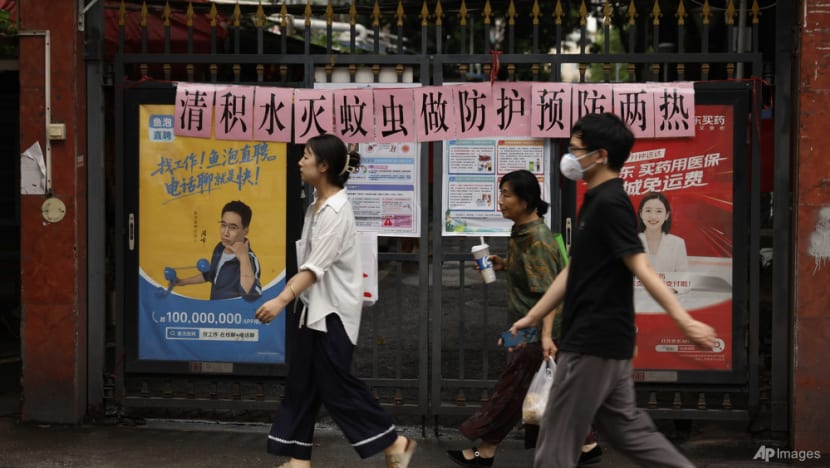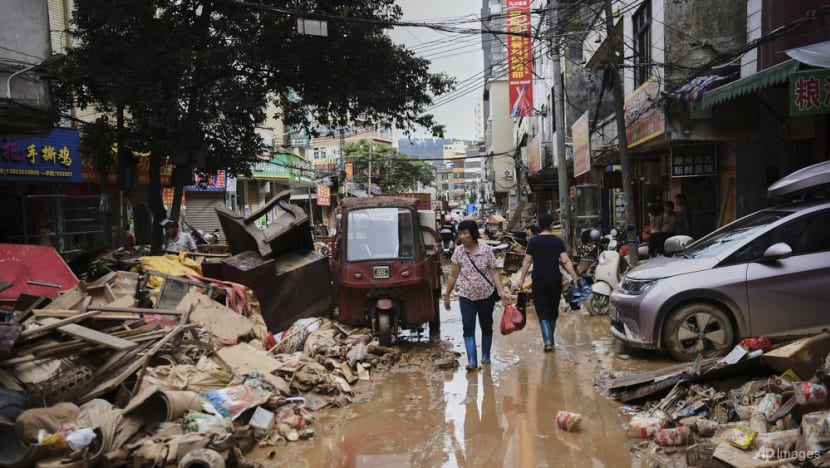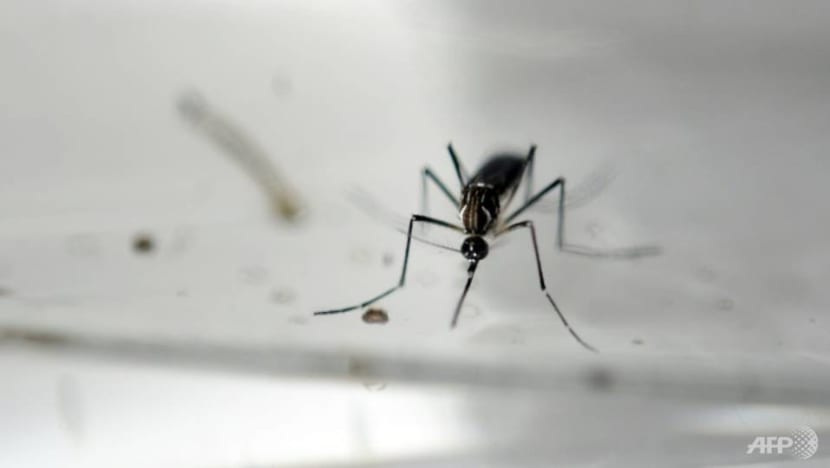Did Chinese authorities take a page from the COVID-19 playbook for chikungunya?
Local government measures to control spread of the mosquito-borne disease spark pandemic memories for some residents.

Residents walk past a residential entrance gate displaying a slogan urging mosquito control, in Guangzhou, China's Guangdong Province, on Aug 6, 2025. The slogan reads "Let's work together to clear stagnant water and eliminate mosquito breeding". (Photo: Chinatopix via AP)

This audio is generated by an AI tool.
An official visited the house but was denied entry, prompting the village’s Communist Party secretary to lead a task force to the building, knocking and shouting at the front door until the residents finally came downstairs.
According to an article on the Nanhai district government’s official WeChat account on Jul 26, the team explained the hazards of breeding mosquitoes, the potential consequences of the disease, as well as the laws and regulations on pandemic prevention.
On the top floor of the residence, the task force found “a dozen buckets containing muddy, stagnant water and, upon closer inspection, swarms of wriggling mosquito larvae”, the article said.
In the battle against the mosquito-borne viral disease, Chinese authorities have turned to a familiar playbook, with some measures – such as quarantine, disinfection of neighbourhoods and real-name registration for fever medicine – recalling the response to COVID-19.
Some of the more intrusive measures have sparked concerns and complaints – such as a Beijing News report about a child with a fever whose parents refused to let community workers take a blood sample on Aug 3.
The following day, police and local staff returned to the house, in the west Guangdong city of Zhanjiang, where they found the child alone and drew some blood, according to the report.
The chikungunya outbreak began with an imported case that was detected in Foshan on Jul 8. Within a month, more than 7,000 cases had been reported in China, mostly in Guangdong.
Those affected have been quarantined in hospital wards, with screens on windows and doors to keep mosquitoes out.
Last week, Foshan upgraded its public health emergency response to level 3 – the second lowest in a four-tier system – while a neighbouring city issued a travel advisory, urging people returning from disease-hit areas to monitor themselves for two weeks.
Grass-roots cadres in the province have been working overtime, spraying parks and pavements with insecticide and checking door-to-door for stagnant water. Residents who do not comply face fines or even criminal charges under public health regulations.
Electricity supply was cut to at least five houses to force residents to cooperate, according to a government notice. In Foshan’s Chancheng district, warnings were issued to hotels and housing compounds after inspectors found larvae in flower vases and swimming pools.
On Thursday, Foshan also launched a patriotic health campaign – a concept from the Mao Zedong era – asking companies, factories and residential compounds to thoroughly clean garages, bushes, ditches and balconies, removing water and rubbish.
The measures brought back painful memories, with some people complaining on social media that their rented rooms had been forcibly entered by landlords and community workers, much like during the zero-COVID period. None responded to the South China Morning Post’s interview requests.
The outbreak and corresponding response were much lighter than during zero-COVID, when homes were sealed, some babies were taken to group quarantine, and even a few pets were killed to stop the spread.

While chikungunya can be serious for the elderly and newborns, most people recover from the disease within a week and are likely to experience months of joint pain as a side effect.
A Foshan resident surnamed Zeng told the Post that community workers visited once to check for stagnant water and register how many people lived in the flat, and they had not returned.
According to Zeng, volunteers have been spraying insecticide and placing mosquito repellents in lifts. When he took his child to hospital recently with a fever, he was asked to sign a document saying he would be responsible for any public health consequences, as a formality, he said.
“It wasn’t as strict as COVID times. Most of the measures were auxiliary, there aren’t any stringent control or quarantine requirements on the general public,” Zeng said, adding that he was receiving several cautionary text messages from the local governments each day at most.

An infectious diseases expert in Guangdong said that some of the measures taken by authorities were justified by the unique circumstances of the disease, including that there were no chikungunya vaccines available in China.
“We need to contain the source of infection and cut transmission routes to protect those vulnerable and identify cases. These measures would effectively contain the disease.”
According to the expert, who requested anonymity, the official data indicated a decline in the number of new cases.
The Guangdong Provincial Centre for Disease Control and Prevention (CDC) reported a downward trend in new cases as of last Saturday, with Shunde district – the core affected area – showing consecutive daily declines.
However, prevention efforts continued to face “complex and severe challenges” because of rainfall and international travel, the CDC said.
Yanzhong Huang, a senior fellow for global health at the Council on Foreign Relations, said a mobilisational, elimination-centred approach had its downsides.
“It’s disproportionate to a vector-borne disease with very low mortality. It may create public resistance and may not be sustainable in the long term,” he said, adding that a more targeted and less coercive approach would prove equally effective.
Measures taken by other countries have included targeted vector control, community education, voluntary compliance and sustainable environmental management rather than mass mobilisation, according to Huang.
He added that the World Health Organization and the US CDC emphasised prevention through repellents, protective clothing and the elimination of mosquito breeding sites.
This article was first published on SCMP.



















